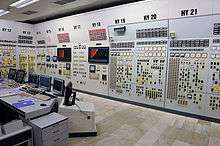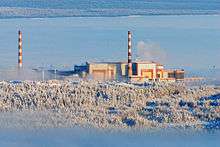Nuclear power in Russia
In 2012 total electricity generated in nuclear power plants in Russia was 177.3 TWh, 17.78% of all power generation. The installed gross capacity of Russian nuclear reactors stood at 25,242 MW.
The Russian energy strategy of 2003 set a policy priority for reduction in natural gas based power supply, aiming to achieve this through a doubling of nuclear power generation by 2020. In 2006 the Federal Atomic Energy Agency (Rosatom) announced targets for future nuclear power generation; providing 23% of electricity needs by 2020 and 25% by 2030.[1] In 2013 the Russian state allocated 80.6 billion rubles ($2.4 billion) toward the growth of its nuclear industry, especially export projects where Russian companies build, own and operate the power station, such as the Akkuyu Nuclear Power Plant.[2]
Russia has made plans to increase the number of reactors in operation from 31 to 59. Old reactors will be maintained and upgraded, including RBMK units similar to the reactors at Chernobyl. China and Russia agreed on further cooperation in the construction of nuclear power stations in October 2005.
In accord with legislation passed in 2001, all Russian civil reactors are operated by Energoatom. More recently in 2007 Russian Parliament adopted the law "On the peculiarities of the management and disposition of the property and shares of organizations using nuclear energy and on relevant changes to some legislative acts of the Russian Federation", which created Atomenergoprom - a holding company for all Russian civil nuclear industry, including Energoatom, nuclear fuel producer and supplier TVEL, uranium trader Tekhsnabexport (Tenex) and nuclear facilities constructor Atomstroyexport.
Through membership in the ITER project, Russia is participating in the design of nuclear fusion reactors.
The Russian government plans to allocate 127 billion rubles ($5.42 billion) to a federal program dedicated to the next generation of nuclear energy technology. About 1 trillion rubles ($42.7 billion) is to be allocated from the federal budget to nuclear power and industry development before 2015.[3]
The overnight cost of construction in the seventies was 800 $/kWh in 2016 dollars.[4]
The Russian nuclear industry employs around 200,000 people.[5] Russia is recognized for its nuclear disaster expertise and for the safety of its technology.[6][7][8][9]
Russia is also pursuing an ambitious plan to increase sales of Russian-built reactors overseas.[10] The VVER-1200 pressurised water reactor is the system currently offered for construction, being an evolution of the VVER-1000 with increased power output to about 1200 MWe (gross) and providing additional passive safety features.[11] In August 2016 the first VVER-1200, Novovoronezh II-1, was connected to the grid.[12]
In 2016 initial plans were announced to build 11 new nuclear power reactors by 2030, including the first VVER-600, a smaller two cooling circuit version of the VVER-1200, designed for smaller regions and markets.[13] Outline plans for near-surface disposal facilities for low and intermediate-level waste, and deep burial disposal facilities for high-level waste were also approved in the Krasnoyarsk Krai region.[13]
Nuclear power reactors
Reactors in operation

Eleven of Russia's reactors are of the RBMK 1000 type, similar to the one at Chernobyl Nuclear Power Plant. Some of these RBMK reactors were originally to be shut down but have instead been given life extensions and uprated in output by about 5%. Critics say that these reactors are of an "inherently unsafe design", which cannot be improved through upgrades and modernization, and some reactor parts are impossible to replace. Russian environmental groups say that the lifetime extensions "violate Russian law, because the projects have not undergone environmental assessments".[14]

| Name | Location | Type | Capacity, MWe | Operational | Notes |
|---|---|---|---|---|---|
| Obninskaya | Obninsk | AM-1 | 5 | 1954–2002 | World's first NPP |
| Sibirskaya | Seversk | EI-2 | 100 | 1958–1990 | |
| ADE-3 | 1961–1992 | ||||
| ADE-4 | 1963–2008 | ||||
| ADE-5 | 1965–2008 | ||||
| Beloyarskaya | Zarechny | AMB-100 | 108 | 1964–1981 | |
| AMB-200 | 260 | 1967–1989 | |||
| BN-600 | 600 | 1980– | |||
| BN-800 | 864 | 2014– | |||
| Dimitrovgradskaya | Dimitrovgrad | BOR-60 | 12 | 1968– | |
| Novovoronezhskaya | Novovoronezh | VVER | 210 | 1964–1984 | |
| VVER | 365 | 1969–1990 | |||
| VVER | 417 | 1971– | |||
| VVER | 417 | 1972– | |||
| VVER | 1000 | 1980– | |||
| Leningradskaya | Sosnovy Bor | RBMK | 1000 | 1973– | |
| RBMK | 1000 | 1975– | |||
| RBMK | 1000 | 1979– | |||
| RBMK | 1000 | 1981– | |||
| Kolskaya | Polyarnye Zori | VVER | 440 | 1973– | |
| VVER | 440 | 1974– | |||
| VVER | 440 | 1981– | |||
| VVER | 440 | 1984– | |||
| Bilibinskaya | Bilibino | EGP | 12 | 1974– | combined heat and power production |
| EGP | 12 | 1974– | |||
| EGP | 12 | 1975– | |||
| EGP | 12 | 1976– | |||
| Kurskaya | Kurchatov | RBMK | 1000 | 1976– | |
| RBMK | 1000 | 1979– | |||
| RBMK | 1000 | 1983– | |||
| RBMK | 1000 | 1985– | |||
| Smolenskaya | Desnogorsk | RBMK | 1000 | 1982– | |
| RBMK | 1000 | 1985– | |||
| RBMK | 1000 | 1990– | |||
| Kalininskaya | Udomlya | VVER | 1000 | 1984– | |
| VVER | 1000 | 1986– | |||
| VVER | 1000 | 2004– | |||
| VVER | 1000 | 2011– | |||
| Balakovskaya | Balakovo | VVER | 1000 | 1985– | |
| VVER | 1000 | 1987– | |||
| VVER | 1000 | 1988– | |||
| VVER | 1000 | 1993– | |||
| Rostovskaya | Volgodonsk | VVER | 1000 | 2001– | |
| VVER | 1000 | 2009- | |||
Nuclear power reactors under construction
| Reactor | Type | MWe net | MWe gross | Construction start | Will be commercially operational |
|---|---|---|---|---|---|
| Akademik_Lomonosov-1/2 | KLT-40S | 64 (2x32) | 70 (2x35) | 2007-05-15 | 2017 |
| Baltiiskaya-1/2 | VVER-1200 | 1109 | 1194 | 2012-02-22 | 2018 |
| Beloyarsk-4 | FBR BN-800 | 789 | 864 | 2006-07-18 | 2015 Completed |
| Leningrad 2-1 | VVER-1200/V491 | 1085 | 1170 | 2008-10-25 | 2018 |
| Leningrad 2-2 | VVER-1200/V491 | 1085 | 1170 | 2010-04-15 | 2019 |
| Novovoronezh 2-1 | VVER-1200/V392М | 1114 | 1200 | 2008-06-24 | 2017 |
| Novovoronezh 2-2 | VVER-1200/V392М | 1114 | 1200 | 2009-07-12 | 2019 |
| Rostov-3 | VVER-1000 | 1011 | 1100 | 2009-09-15 | 2015 Completed |
| Rostov-4 | VVER-1000 | 1011 | 1100 | 2010-06-16 | 2017 |
| Total: 8(10) | 8382 | 9068 |
International NPP projects in the Russian nuclear industry
| Country | NPP Reactor | Type | MWe net | MWe gross | Construction start | Commercially operational |
|---|---|---|---|---|---|---|
| Turkey | Akkuyu-1/2/3/4 | VVER-1200/491 | 1115 | 1200 | 2014(1st block) | 2019(1st block) |
| Belarus | Belarusian-1 | VVER-1200 | 1115 | 1200 | July 2013 | 2018 |
| Belarusian-2 | VVER-1200 | 1115 | 1200 | 2020 | ||
| Iran | Bushehr-1 | VVER-1000/446 | 915 | 1000 | 1975-05-01 (1995) | 2013 |
| Bushehr-2 | VVER-1000/446 | 915 | 1000 | 2012-07-30 | ||
| Bushehr-3 | VVER-1000/446 | 915 | 1000 | 2013-07-30 | ||
| India | Kudankulam-1 | VVER-1000/412 | 917 | 1000 | 2002-03-31 | 2013-07-13 |
| Kudankulam-2 | VVER-1000/412 | 917 | 1000 | 2002-07-04 | ||
| Kudankulam-3/4 | VVER-1000/412 | 917 | 1000 | negotiation | ||
| Slovakia | Mochovce-3/4 | VVER-440 | 440 | 471 | 1987-01-27 (November 2008) | 2017 |
| Vietnam | Ninh Thuan 1-1/2 | VVER-1000/428 | 950 | 1000 | 2014(1st block) | 2020(1st block) |
| Ninh Thuan 1-3/4 | VVER-1000/428 | 950 | 1000 | negotiation | ||
| China | Tianwan-1 | VVER-1000/428 | 990 | 1060 | 1999-10-20 | 2007-05-17 |
| Tianwan-2 | VVER-1000/428 | 990 | 1060 | 2000-10-20 | 2007-08-16 | |
| Tianwan-3/4 | VVER-1000/428М | 1050 | 1126 | 2012-12-27 | 2018 | |
| Ukraine | Khmelnitskiy-3/4 | VVER-1000/392B | 950 | 1000 | negotiation | 2020 |
In addition Atomstroyexport challenging NPP projects list contains:[15]
- Temelin NPP Power Units 3/4 (Czech Republic)
- Jordan NPP (single-unit NPP with an option for the second power unit)[16]
- Metsamor NPP Power Units 3/4 (Armenia)
- NPP with the Reactor Plant VBER-300 (Kazakhstan)
- Sanming NPP (China)
Nuclear Engineering Companies
- Atomenergomash - power engineering company; produces steam generators for NPPs
- Atommash - by far Russia's largest nuclear engineering plant designed to build up to 8 reactors per year, but after the collapse of the USSR reorganized privately by Energomash and today not able to produce reactor vessels
- Atomstroyexport - nuclear power equipment and service export monopoly
- OKBM Afrikantov - nuclear reactor design and engineering company
- OKB Gidropress - nuclear reactor design and engineering company
Safety
Russia, responding to the 2011 Japanese nuclear accidents, will perform a 'stress test' on all its reactors "to judge their ability to withstand earthquakes more powerful than the original design anticipated".[17]
See also
| Wikimedia Commons has media related to Commons:RIA Novosti/Nuclear industry. |
References
- ↑
- ↑ "Russia invests in nuclear". World Nuclear News. 20 December 2013. Retrieved 21 December 2013.
- ↑ RIA Novosti
- ↑ USA. (1982). Technology and Soviet energy availability. Boulder (Colo.: Westview press. p. 126.
- ↑ "Nuclear rethink urged". The Moscow News. 21 March 2011.
- ↑ "Benchmarking the global nuclear industry 2012 Heading for a fast recovery" (PDF). E&Y. 2012-10-11. Retrieved 2014-10-13.
- ↑ "Rosatom today and overview of its current and prospective Nuclear Power Plant projects" (PDF). Rosatom. 2013-08-21. Retrieved 2014-10-13.
- ↑ "International Standards of Safety and the Modern Projects of Nuclear Power Stations" (PDF). Rosatom. 2013-11-04. Retrieved 2014-10-14.
- ↑ "Russia's efforts to improve safety following the Chernobyl and the Fukushima accidents" (PDF). IBRAE. 2013-11-06. Retrieved 2014-10-14. External link in
|publisher=(help) - ↑ Pulitzer Center On Crisis Reporting
- ↑ Nikolay Fil (26–28 July 2011). "Status and perspectives of VVER Status and perspectives of VVER nuclear power plants nuclear power plants" (PDF). OKB Gidropress. IAEA. Retrieved 28 September 2011.
- ↑ "Russia connects Novovoronezh 6 reactor to grid". World Nuclear News. 5 August 2016. Retrieved 17 September 2016.
- 1 2 "Russia to build 11 new nuclear reactors by 2030". World Nuclear News. 10 August 2016. Retrieved 17 September 2016.
- ↑ Igor Koudrik and Alexander Nikitin (13 December 2011). "Second life: The questionable safety of life extensions for Russian nuclear power plants". Bulletin of the Atomic Scientists.
- ↑ Challenging NPP Projects JSC ASE
- ↑ NPP JSC ASE (Jordan)
- ↑ Matthew L. Wald (24 March 2011). "Russia Plans to Test Reactors For Ability to Survive Quakes". New York Times.



